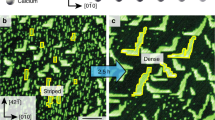Abstract
Nowadays, complex chemical problems such as the origin and mechanism of molecular recognition and self-assembly can be addressed computationally, using high performance resources. This is illustrated in the following, using the adsorption of small amino acids and DNA base molecules on metals as an example. First-principles calculations are used to rationalize the long-range chiral recognition between adenine and phenylglycine adsorbed on Cu(110) [Chen and Richardson, Nature Materials 2, 324 (2003)]. The enantiomeric interaction is traced to substrate-mediated Coulomb repulsion and template effects. The mechanism revealed here (i) shows that the Easson and Stedman model for chiral recognition may include long-range electrostatic interactions and (ii) illustrates the catalytic potential of the substrate for molecular self-assembly.
Access this chapter
Tax calculation will be finalised at checkout
Purchases are for personal use only
Preview
Unable to display preview. Download preview PDF.
Similar content being viewed by others
References
Bader, R.F.W.: Atoms in molecules: A quantum theory. Oxford, USA (1990)
Blankenburg, S., Schmidt, W.G.: Adsorption of phenylglycine on copper: Density functional calculations. Phys. Rev. B 74, 155419 (2006)
Blankenburg, S., Schmidt, W.G.: Steric effects and chirality in the adsorption of glycine and phenylglycine on Cu(110). Nanotechnology 18, 424030 (2007)
Booth, T.D., Wahnon, D., Wainer, I.W.: Is chiral recognition a three-point process? Chirality 9, 96 (1997)
Chen, Q., Richardson, N.V.: Enantiomeric interactions between nucleic acid bases and amino acids on solid surfaces. Nature Materials 2, 324 (2003)
Di Felice, R. Selloni, A. Adsorption modes of cysteine on Au(111): Thiolate, amino-thiolate, disulfide. J. Chem. Phys. 120, 4906 (2004)
Easson, E.H., Stedman, E.: Studies on the relationship between chemical constitution and physiological action. Biochem. J. 27, 1257 (1933)
Ernst, K.H., Kuster, Y., Fasel, R., Müller, M., Ellerbeck, U.: Two-dimensional separation of [7]helicene enantiomers on Cu(111). Chirality 13, 675 (2001)
Hamann, D.R.: H2O hydrogen bonding in density-functional theory. Phys. Rev. B 55, R10,157 (1997)
Hauschild, A., Karki, K., Cowie, B.C.C., Rohlfing, M., Tautz, F.S., Sokolowski, M.: Molecular distortions and chemical bonding of a large π-conjugated molecule on a metal surface. Phys. Rev. Lett. 94, 036106 (2005)
Jones, G., Jenkins, S.J., King, D.A.: Hydrogen bonds at metal surfaces: Universal scaling and quantification of substrate effects. Surf. Sci. 600, L224 (2006)
Kresse, G., Furthmüller, J.: Efficiency of ab-initio total energy calculations for metals and semiconductors using a plane-wave basis set. Comput. Mater. Sci. 6, 15 (1996)
Kresse, G., Joubert, D.: From ultrasoft pseudopotentials to the projector augmented-wave method. Phys. Rev. B 59, 1758 (1999)
Kühnle, A., Linderoth, T.R., Hammer, B., Besenbacher, F.: Chiral recognition in dimerization of adsorbed cysteine observed by scanning tunneling microscopy. Nature 415, 891 (2002)
Lorenzo, M.O., Baddeley, C.J., Muryn, C., Raval, R.: Extended surface chirality from supramolecular assemblies of adsorbed chiral molecules. Nature 404, 376 (2000)
Lukas, S., Witte, G., Wöll, C.: Novel mechanism for molecular self-assembly on metal substrates: Unidirectional rows of pentacene on Cu(110) produced by a substrate-mediated repulsion. Phys. Rev. Lett. 88, 028,301 (2002)
Nilsson, A., Pettersson, L.G.M.: Chemical bonding on surfaces probed by x-ray emission spectroscopy and density functional theory. Surf. Sci. Rep. 55, 49 (2004)
Northrup, J.E., Froyen, S.: Structure of GaAs(001) surfaces: The role of electrostatic interactions. Phys. Rev. B 50, 2015 (1994)
Nyberg, M., Odelius, M., Nilsson, A., Pettersson, L.G.M.: Hydrogen bonding between adsorbed deprotonated glycine molecules on Cu(110). J. Chem. Phys. 119, 12577 (2003)
Ortmann, F., Schmidt, W.G., Bechstedt, F.: Attracted by long-range electron correlation: Adenine on graphite. Phys. Rev. Lett. 95, 186101 (2005)
Perdew, J.P., Chevary, J.A., Vosko, S.H., Jackson, K.A., Pederson, M.R., Fiolhais, D.J.S.C.: Atoms, molecules, solids, and surfaces: Applications of the generalized gradient approximation for exchange and correlation. Phys. Rev. B 46, 6671 (1992)
Preuss, M., Schmidt, W.G., Bechstedt, F.: Coulombic amino group-metal bonding: Adsorption of adenine on cu(110). Phys. Rev. Lett. 94, 236102 (2005)
Schmidt, W.G., Seino, K., Preuss, M., Hermann, A., Ortmann, F., Bechstedt, F.: Organic molecule adsorption on solid surfaces: chemical bonding, mutual polarisation and dispersion interaction. Appl. Phys. A 85, 387 (2006)
Thierfelder, C., Hermann, A., Schwerdtfeger, P., Schmidt, W.G.: Strongly bonded water monomers on the ice ih basal plane: Density-functional calculations. Phys. Rev. B 74, 045,422 (2006)
Author information
Authors and Affiliations
Editor information
Rights and permissions
Copyright information
© 2009 Springer-Verlag Berlin Heidelberg
About this paper
Cite this paper
Blankenburg, S., Schmidt, W.G. (2009). Understanding Molecular Recognition and Self-Assembly from Large-Scale Numerical Simulations. In: Resch, M., et al. High Performance Computing on Vector Systems 2008. Springer, Berlin, Heidelberg. https://doi.org/10.1007/978-3-540-85869-0_12
Download citation
DOI: https://doi.org/10.1007/978-3-540-85869-0_12
Publisher Name: Springer, Berlin, Heidelberg
Print ISBN: 978-3-540-85868-3
Online ISBN: 978-3-540-85869-0
eBook Packages: Mathematics and StatisticsMathematics and Statistics (R0)




